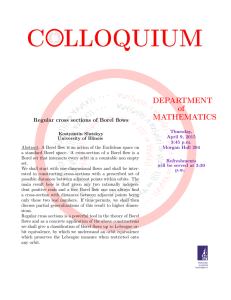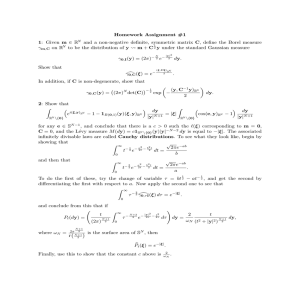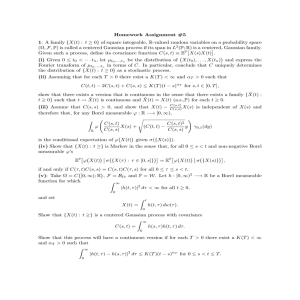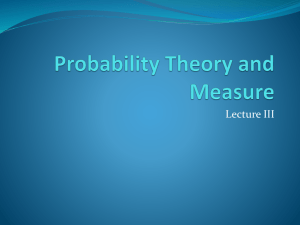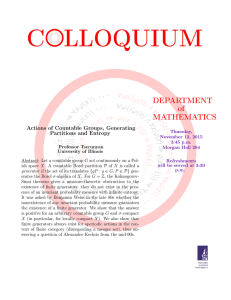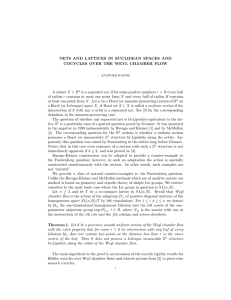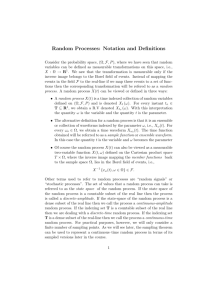Armand Borel (1923–2003)
advertisement
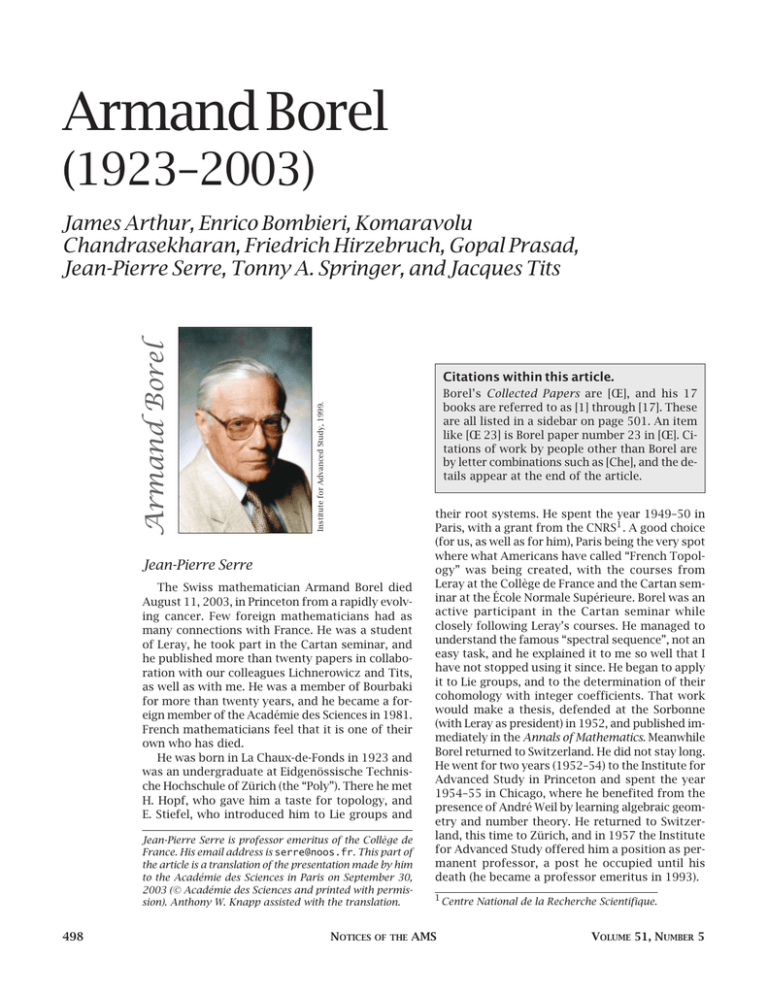
Armand Borel (1923–2003) Citations within this article. Borel’s Collected Papers are [Œ], and his 17 books are referred to as [1] through [17]. These are all listed in a sidebar on page 501. An item like [Œ 23] is Borel paper number 23 in [Œ]. Citations of work by people other than Borel are by letter combinations such as [Che], and the details appear at the end of the article. Institute for Advanced Study, 1999. Armand Borel James Arthur, Enrico Bombieri, Komaravolu Chandrasekharan, Friedrich Hirzebruch, Gopal Prasad, Jean-Pierre Serre, Tonny A. Springer, and Jacques Tits Jean-Pierre Serre The Swiss mathematician Armand Borel died August 11, 2003, in Princeton from a rapidly evolving cancer. Few foreign mathematicians had as many connections with France. He was a student of Leray, he took part in the Cartan seminar, and he published more than twenty papers in collaboration with our colleagues Lichnerowicz and Tits, as well as with me. He was a member of Bourbaki for more than twenty years, and he became a foreign member of the Académie des Sciences in 1981. French mathematicians feel that it is one of their own who has died. He was born in La Chaux-de-Fonds in 1923 and was an undergraduate at Eidgenössische Technische Hochschule of Zürich (the “Poly”). There he met H. Hopf, who gave him a taste for topology, and E. Stiefel, who introduced him to Lie groups and Jean-Pierre Serre is professor emeritus of the Collège de France. His email address is serre@noos.fr. This part of the article is a translation of the presentation made by him to the Académie des Sciences in Paris on September 30, 2003 (© Académie des Sciences and printed with permission). Anthony W. Knapp assisted with the translation. 498 NOTICES OF THE their root systems. He spent the year 1949–50 in Paris, with a grant from the CNRS1 . A good choice (for us, as well as for him), Paris being the very spot where what Americans have called “French Topology” was being created, with the courses from Leray at the Collège de France and the Cartan seminar at the École Normale Supérieure. Borel was an active participant in the Cartan seminar while closely following Leray’s courses. He managed to understand the famous “spectral sequence”, not an easy task, and he explained it to me so well that I have not stopped using it since. He began to apply it to Lie groups, and to the determination of their cohomology with integer coefficients. That work would make a thesis, defended at the Sorbonne (with Leray as president) in 1952, and published immediately in the Annals of Mathematics. Meanwhile Borel returned to Switzerland. He did not stay long. He went for two years (1952–54) to the Institute for Advanced Study in Princeton and spent the year 1954–55 in Chicago, where he benefited from the presence of André Weil by learning algebraic geometry and number theory. He returned to Switzerland, this time to Zürich, and in 1957 the Institute for Advanced Study offered him a position as permanent professor, a post he occupied until his death (he became a professor emeritus in 1993). 1 Centre National de la Recherche Scientifique. AMS VOLUME 51, NUMBER 5 again, Borel’s extensive knowledge of the literature played a role. Inspired by a recent paper of V. P. Platonov, he had written a note proving the analog for simple groups over algebraically closed fields of a classical result of V. V. Morozov: a maximal proper subalgebra of a semisimple complex Lie algebra either is semisimple or contains a maximal nilpotent subalgebra. Borel sent a copy of the manuscript of this note to a mutual friend of ours, who showed it to me. I observed that the argument of Borel’s proof could be adapted to a considerably more general setting and provided results over arbitrary fields, for instance the following fact, which turned out to be of great importance in finite group theory: if G is a reductive k -group (k being any field) and U is a split25 unipotent subgroup, then there exists a parabolic k -subgroup P of G whose unipotent radical contains U such that every k -automorphism of G preserving U also preserves P ; then, in particular, P contains the normalizer of U . (Much earlier, I had conjectured this fact and given a case-by-case proof “in most cases”, but the new approach, using Borel’s argument, gave a uniform and much simpler proof.) I mention en passant the complements [Œ 94] to “Groupes réductifs”, containing results concerning, among other things, the closure of Bruhat cells in topological reductive groups and the fundamental group of real algebraic simple groups. The last joint paper by Borel and me is a Comptes Rendus note [Œ 97] that in personal discussions we nicknamed “Nonreductive groups”. Indeed, we had discovered that many of our results on reductive groups could, after suitable reformulation, be generalized to arbitrary connected algebraic groups. Examples are the conjugacy by elements rational over the ground field, of maximal split tori, of maximal split unipotent subgroups, and of minimal pseudoparabolic subgroups,26 or the existence of a BN-pair (hence of a Bruhat decomposition). Complete proofs of those results never got published, but both Borel and I, independently, lectured about them (he at Yale University, and I at the Collège de France). 25 A unipotent group over a field k is said to be split if it has a composition series over k , all quotients of which are additive groups. 26 Pseudoparabolic subgroups are a substitute for para- bolic subgroups that one must use when dealing with nonreductive groups over nonperfect fields. 518 NOTICES OF THE James Arthur My topic is Armand Borel and the theory of automorphic forms. Borel’s most important contributions to the area are undoubtedly those established in collaboration with Harish-Chandra [Œ 54, 58]. They include the construction and properties of approximate fundamental domains, the proof of finite volume of arithmetic quotients, and the characterization in terms of algebraic groups of those arithmetic subgroups that give compact quotients. These results created the opportunity for working in the context of general algebraic groups. They laid the foundations of the modern theory of automorphic forms that has flourished for the past forty years. The classical theory of modular forms concerns holomorphic functions on the upper half plane H that transform in a certain way under the action of a discrete subgroup Γ of SL(2, R) . The multiplicative group SL(2, R) consists of the 2 × 2 real matrices of determinant 1, and each element ab γ = c d of SL(2, R) acts on H by the linear az+b fractional transformation z → cz+d . For example, one can take Γ to be the subgroup SL(2, Z) of integral matrices or, more generally, the congruence subgroup Γ (N) = γ ∈ SL(2, Z) : γ ≡ I mod N attached to a positive integer N . The theory began as a branch of complex analysis. However, with the work of E. Hecke, it acquired a distinctive number theoretic character. Hecke introduced a commuting family of linear operators on any space of automorphic forms for Γ (N) , one for each prime not dividing N , with interesting arithmetic properties. We now know that eigenvalues of the Hecke operators govern how prime numbers p split in certain nonabelian Galois extensions of the field Q of rational numbers [Sh], [D]. Results of this nature are known as reciprocity laws and are in some sense the ultimate goal of algebraic number theory. They can be interpreted as a classification for the number fields in question. The Langlands program concerns the generalization of the theory of modular forms from the group of 2 × 2 matrices of determinant 1 to an arbitrary reductive group G . It is believed to provide reciprocity laws for all finite algebraic extensions of Q . Let us use the results of Borel and HarishChandra as a pretext for making a very brief excursion into the general theory of automorphic forms. In so doing, we can follow a path illuminated by Borel himself. The expository articles and monographs of Borel encouraged a whole generation of James Arthur is professor of mathematics at the University of Toronto and president elect of the AMS. His email address is arthur@math.utoronto.ca. AMS VOLUME 51, NUMBER 5 mathematicians to pursue the study of automorphic forms for general algebraic groups. Together with the mathematical conferences he organized, they have had extraordinary influence. The general theory entails two reformulations of the classical theory of modular forms. The first is in terms of the unitary representation theory of the group SL(2, R) . The action of SL(2, R) on H √ is transitive. Since the stabilizer of the point i = −1 is the special orthogonal group cos θ sin θ KR = SO(2, R) = kθ = − sin θ cos θ , one can identify H with the space of cosets SL(2, R)/KR . The space of orbits in H under a discrete group Γ ⊂ SL(2, R) becomes the space of double cosets Γ \SL(2, R)/KR . A modular form of weight 2k is a holomorphic function f on H such that27 f (γz) = (cz + d)2k f (z) ab whenever γ = c d is in Γ . A modular form of weight 2 , for instance, amounts to a holomorphic 1-form f (z)dz on the Riemann surface Γ \H, since d(γz) = (cz + d)−2 dz . For a given f , the function F 2k on SL(2, R) defined by F(g) = (ci + d) f (z) when ab g = c d and z = gi is easily seen to satisfy F(γgkθ ) = F(g)e−2kiθ , for γ ∈ Γ . The requirement that f be holomorphic translates to the condition that F be an eigenfunction of a canonical biinvariant differential operator ∆ on SL(2, R) of degree 2 , with eigenvalue a simple function of k . The theory of modular forms of any weight becomes part of the following more general problem: Decompose the unitary representation of SL(2, R) by right translation on L2 Γ \SL(2, R) into irreducible representations. of Q is a locally compact ring that contains the real field R, as well as completions Qp of Q with respect to the p-adic absolute values |x|p = p−r , x = pr (ab−1 ), (a, p) = (b, p) = 1, on Q . One constructs Qp by a process identical to the completion R of Q with respect to the usual absolute value. In fact, one has an enhanced form of the triangle inequality, |x1 + x2 |p ≤ max |x1 |p , |x2 |p , x1 , x2 ∈ Q, which has the effect of giving the compact “unit ball” Zp = xp ∈ Qp : |xp |p ≤ 1 the structure of a subring of Qp. The complementary factor Afin of R in A is defined as the “restricted” direct product ∼ Qp = x = (xp ) : xp ∈ Qp , xp ∈ Zp for almost all p , 27 There is also a mild growth condition that need not MAY 2004 p prime p That the problem is in fact more general is due to a variant of Schur’s lemma. Namely, as an operator that commutes with SL(2, R) , ∆ acts as a scalar on the space of any irreducible representation. To recover the modular forms of weight 2k , one the irreducible subspaces of would collect L2 Γ \SL(2, R) with the appropriate ∆-eigenvalue, and from each of these, extract the smaller subspace on which the restriction to KR of the corresponding SL(2, R) -representation equals the character kθ → e−2kiθ . This is all explained clearly in Borel’s survey article [Œ 75] in the proceedings of the 1965 AMS conference at Boulder [3]. The Boulder conference was concern us here. organized jointly by Borel and G. D. Mostow. It was a systematic attempt to make the emerging theory of automorphic forms accessible to a wider audience. Borel himself wrote four articles [Œ 73, 74, 75, 76] for the proceedings, each elucidating a different aspect of the theory. The second reformulation is in terms of adeles. Though harder to justify at first, the language of adeles ultimately streamlines many fundamental operations on automorphic forms. The relevant Boulder articles are [T] and [K]. These were not written by Borel, but were undoubtedly commissioned by him as part of a vision for presenting a coherent background from the theory of algebraic groups. The adele ring ∼ A = R × Afin = R × Qp which becomes a locally compact (totally disconnected) ring under the appropriate direct limit topology. The diagonal image of Q in A is a discrete subring. This implies that the group SL(2, Q) of rational matrices embeds into the locally compact group SL(2, A) of unimodular adelic matrices as a discrete subgroup. The theory of automorphic forms on Γ \SL(2, R) , for any congruence subgroup Γ = Γ (N) , becomes part of the following more general problem: Decompose the unitary representation of SL(2, A) by right translation on L2 SL(2, Q)\SL(2, A) into irreducible representations. The reason that the last problem is more general than the previous one is provided by the theorem of strong approximation, which applies to the NOTICES OF THE AMS 519 Photograph by Lyn Howe, provided courtesy of Roger Howe. “Armand Borel Math Camp” at the AMS Summer Institute on automorphic forms, representations, and L -functions at Corvallis, Oregon, 1977. Front: Nick Howe. Back row, left to right: Roger Howe, Armand Borel, Robert Langlands, Bill Casselman, Marie-France Vigneras, Kenneth Ribet. Borel has the special designation “Coach” on his T-shirt and Casselman has the designation “Assistant Coach”. simply connected28 group SL(2) . The theorem asserts that if K is any open compact subgroup of SL(2, Afin ) , then SL(2, A) = SL(2, Q) · (K · SL(2, R)). This implies that if Γ = SL(2, R) ∩ SL(2, Q)K , then there is a unitary isomorphism ∼ L2 SL(2, Q)\SL(2, A)/K −→ L2 Γ \SL(2, R) that commutes with right translation by SL(2, R) . For example, if we take K to be the group K(N) = x = (xp ) : xp ∈ SL(2, Zp ), xp ≡ I mod (M2 (N Zp )) , then Γequals Γ (N) . To recover the decomposition collect the of L2 Γ (N)\SL(2, R) , one would irreducible subspaces of L2 SL(2, Q)\SL(2, A) , and from each of these, extract the smaller subspace for which the restriction to K of the corresponding SL(2, A) -representation is trivial. that the decomposition of Given L2 SL(2, Q)\SL(2, A) includes the classical theory of modular forms, we can see reasons why the adelic formulation is preferable. It treats the theory simultaneously for all weights and all congruence subgroups. It is based on a discrete group SL(2, Q) of rational matrices rather than a group Γ (N) of integral matrices. Most significantly, perhaps, it clearly displays the supplementary structure given by right translation under the group 28 “Simply connected” in this instance means that SL(2, C) is simply connected as a topological space. 520 NOTICES OF THE Figure 1. Standard fundamental domain for the action of SL(2, Z) on the upper half plane, together with a more tractable approximate fundamental domain. The standard fundamental domain, darkly shaded, is the semi-infinite region bounded by the unit circle and the vertical lines at x = ±1/2 . The approximate fundamental domain St generalized by Borel and Harish-Chandra is the total shaded region. SL(2, Afin ) . The unitary representation theory of the p-adic groups SL(2, Qp ) thus plays an essential role in the theory of modular forms. This is the source of the operators discovered by Hecke. Eigenvalues of Hecke operators are easily seen to parametrize irreducible representations of the group SL(2, Qp ) that are unramified in the sense that their restrictions to the maximal compact subgroup SL(2, Zp ) contain the trivial representation. It turns out that in fact any irreducible representation of SL(2, in the Qp ) that occurs decomposition of L2 SL(2, Q)\SL(2, A) carries fundamental arithmetic information. It is now straightforward to set up higherdimensional analogs of the theory of modular forms. One replaces29 the group SL(2) by an arbitrary connected reductive algebraic group G defined over Q . As in the special case of SL(2) , G(Q) embeds as a discrete subgroup of the locally compact group G(A). The Langlands program has to do with the irreducible constituents (known as automorphic representations) of the unitary representation of G( A) by right translation on L2 G(Q)\G(A) . A series of conjectures of Langlands, dating from the mid-1960s through the 1970s, characterizes the internal structure of automorphic representations. The conjectures provide a precise description of the arithmetic data in automorphic representations, together with a formulation of deep and unexpected relationships among these data as G varies (known as the “principle of functoriality”). 29 Even in the classical case, one has to replace SL(2) by the slightly larger group GL(2) to obtain all the operators defined by Hecke. AMS VOLUME 51, NUMBER 5 General automorphic representations are thus firmly grounded in the theory of algebraic groups. It seems safe to say that the many contributions of Borel to algebraic groups described by Springer and Tits in this article are all likely to have some role to play in the theory of automorphic forms. Borel did much to make the Langlands program more accessible. For example, his Bourbaki talk [Œ 103] in 1976 was one of the first comprehensive lectures on the Langlands conjectures to a general mathematical audience. In 1977 Borel and W. Casselman organized the AMS conference in Corvallis on automorphic forms and L -functions, as a successor to the Boulder conference. It was a meticulously planned effort to present the increasingly formidable background material needed for the Langlands program. The Corvallis proceedings [10] are considerably more challenging than those of Boulder. However, they remain the best comprehensive introduction to the field. They also show evidence of Borel’s firm hand. Speakers were not left to their own devices. On the contrary, they were given specific advice on exactly what aspect of the subject they were being asked to present. Conference participants actually had to share facilities with a somewhat unsympathetic football camp, led by Coach Craig Fertig of the Oregon State University Beavers. At the end of the four weeks, survivors were rewarded with orange T-shirts, bearing the inscription ARMAND BOREL MATH CAMP. Borel himself sported30 a T-shirt with the further designation COACH. Let us go back to the topic we left off earlier, Borel’s work with Harish-Chandra. The action of SL(2, Z) on H has a well-known fundamental domain, given by the darker shaded region in Figure 1. This region is difficult to characterize in terms of the transitive action of SL(2, R) on H . The total shaded rectangular region St in the diagram is more tractable, for there is a topological decomposition SL(2, R) = P (R)KR = N(R)M(R)KR , where P , N , and M are the subgroups of matrices in SL(2) that are respectively upper triangular, upper triangular unipotent, and diagonal. The group N(R) acts by horizontal translation on H , while M(R) acts by vertical dilation. We have already noted that KR stabilizes the point i. We can therefore write St = ωAt · i, 1x : |x| ≤ σ where ω is the compact subset 01 of N(R), and At is the one-dimensional cone a 0 : a > 0, a2 ≥ t . The set St is an 0 a−1 approximate fundamental domain for the action of SL(2, Z) on H , in the sense that it contains a set of representatives of the orbits, while there are 30 See the photograph on the previous page. MAY 2004 only finitely many γ ∈ SL(2, Z) such that St and γSt intersect. For a general group G , the results of Borel and Harish-Chandra provide an approximate fundamental domain for the action of G(Q) by left translation on G(A) . To describe it, I have to rely on a few notions from the theory of algebraic groups. Let me write P for a minimal parabolic subgroup of G over Q , with unipotent radical N and Levi component M . The adelic group M(A) can be written as a direct product M(A)1 AM (R)0 , where AM is the Q -split part of the center of M , AM (R)0 is the connected component of 1 in AM (R) , and M(A)1 is a canonical complement of AM (R)0 in M(A) that contains M(Q) . The roots of (P , AM ) are characters a−→aα on AM that determine a cone At = a ∈ AM (R)0 : aα ≥ t, for every α in AM (R)0 for any t > 0 . Suppose that KA = KR Kfin is a maximal compact subgroup of G(A) . If Ω is a compact subset of N(A)M(A)1 , the product St = ΩAt KA is called a Siegel set in G(A), following special cases introduced by C. L. Siegel. One of the principal results of [Œ 58] implies that for suitable choices of KA , Ω , and t , the set St is an approximate fundamental domain for G(Q) in G(A) . The obstruction to G(Q)\G(A) being compact is thus governed by the cone At in the group AM (R)0 ∼ = Rdim AM . It follows that G(Q)\G(A) is compact if and only if AM is trivial, which is to say that G has no proper parabolic subgroup over Q and no Q -split central subgroup. This is essentially the criterion of [Œ 58].31 Borel and HarishChandra obtained other important results from their characterization of approximate fundamental domains. For example, in the case of semisimple G , they proved that the quotient G(Q)\G(A) has finite volume with respect to the Haar measure of dx on G(A) . This is a consequence of a decomposition formula for Haar measures dx = a−2ρ dω da dk , where ω is in Ω , a is in At , and k is in KA and where 2ρ denotes the sum of the roots of (P , AM ) . The papers of Borel and Harish-Chandra were actually written for arithmetic quotients Γ \G(R) of real groups, as were the supplementary articles [Œ 59, 61] of Borel. Prodded by A. Weil [W, p. 25], Borel wrote two parallel papers [Œ 55, 60] that formulated the results in adelic terms and established many basic properties of adele groups.32 His 31 A similar result was established independently by Mostow and Tamagawa [MT]. 32 In his 1963 Bourbaki lecture [G], R. Godement presented an alternative argument, which he also formulated in adelic terms. NOTICES OF THE AMS 521 Photograph by C. J. Mozzochi. later lecture notes [Œ 79], written again in the setting of real groups, immediately became a standard reference. Borel and Harish-Chandra were probably motivated by the 1956 paper [Sel] of A. Selberg. Selberg brought many new ideas to the study of the spectral decomposition of L2 Γ \SL(2, R) , including a construction of the continuous spectrum by means of Eisenstein series and a trace formula for analyzing the discrete spectrum. A familiarity with the results of Siegel no doubt gave Borel and Harish-Chandra encouragement for working with general groups. Their papers Werner Mueller, Leslie Saper, and Borel were followed in (left to right) at the Park City Summer the mid-1960s Institute, 2002. by Langlands’s manuscript on general Eisenstein series (published only later in 1976 [L]). In the context of adele groups, Langlands’s results give a complete description of the continuous spectrum of L2 G(Q)\G(A) . A starting point was the work of Borel and Harish-Chandra and, in particular, the properties of approximate fundamental domains. In recent years Borel lectured widely on the theory of Eisenstein series: in the three-year Hong Kong program mentioned by Bombieri, for example, and the 2002 summer school in Park City. One of his ambitions, alas unrealized, was to write an introductory volume on the general theory of Eisenstein series. In attempting to give a sense of both the scope of the field and Borel’s substantial influence, I have emphasized Borel’s foundational work with HarishChandra and his leading role in making the subject more accessible. Borel made many other important contributions. These were often at the interface of automorphic forms with geometry, especially as it pertains to the locally symmetric spaces XΓ = Γ \G(R)/KR . Elements in the deRham cohomology group H ∗ (XΓ , C) are closely related to automorphic forms for G , as we have already noted in the special case of modular forms of weight 2 . This topic was fully explored in Borel’s monograph [Œ 115, 172] with N. Wallach. Borel collaborated in the creation of two very distinct compactifications of spaces XΓ : one with W. Baily [Œ 63, 69], the other with J-P. Serre [Œ 90, 98]. The Baily-Borel compactification became the setting for the famous correspondence 522 NOTICES OF THE between intersection cohomology (discovered by Goresky and MacPherson in the 1970s) and L2cohomology (applied to square integrable differential forms on XΓ ), a relationship first conjectured by S. Zucker.33 The L2-cohomology of XΓ is the appropriate analog of deRham cohomology in case XΓ is noncompact. Its relations with automorphic forms were investigated by Borel and Casselman [Œ 126, 131]. In general, the cohomology groups of spaces XΓ are very interesting objects, which retain many of the deepest properties of the corresponding automorphic representations. They bear witness to the continuing vitality of mathematics that originated with Borel. Gopal Prasad Borel first visited India in 1961, when he gave a series of lectures on compact and noncompact semisimple Lie groups and symmetric spaces at the Tata Institute of Fundamental Research (TIFR) in Bombay. His course introduced the theory of Lie groups and geometry of symmetric spaces to the first generation of mathematicians at TIFR, who in turn trained the next generations in these areas. Having joined TIFR in 1966, I belong to the second generation, and so I owe a considerable debt to Armand Borel for my education in the theory of Lie groups and even more directly in the theory of algebraic and arithmetic groups, which I learned from his excellent books and numerous papers on these two topics. Subsequently, Borel made many visits to TIFR and other mathematical centers in India. He was deeply interested in the development of mathematical institutions in India and helped several of them with his advice and frequent visits. For his contributions to Indian mathematics, he was made an honorary fellow of TIFR in 1990. During his numerous trips to India, Armand and his wife, Gaby, visited many sites of historical and architectural interest and attended concerts of Indian classical dance and music. He became fond of many forms of Indian classical dances such as Bharat-Natyam, Odissi, and Kathakkali. Even more so, he came to love both Carnatic (south Indian) and Hindustani (north Indian) classical music. He became quite an expert on the subject and developed friendships with many musicians and dancers from India. He invited several of them to perform in the concert series he initiated and directed at the 33 The conjecture was later proved by L. Saper and M. Stern, and E. Looijenga. Gopal Prasad is professor of mathematics at the University of Michigan at Ann Arbor. His email address is gprasad@umich.edu. AMS VOLUME 51, NUMBER 5

